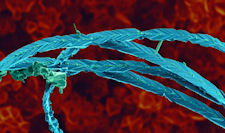Social Implications, Environmental Impact
New technologies often have significant social and environmental implications, and these are not always obvious when they are developed. Consider, for example, how major inventions and devices such as the telephone, the internal combustion engine, the DC motor and the smart phone have changed the societies into which they were introduced. Not surprisingly, new technologies are often accompanied by debates and controversies between the enthusiastic proponents who see economic progress and improved performance, and the opponents who fear harm to the social fabric, malicious uses of the new technology, and damage to the environment.
A key concern with nanotechnology is its potential toxicity. We found many bulk materials (lead, asbestos) are harmful to health — what about nanoparticles or other nanoscale materials? The toxicity of many nanoparticles and nanotubes have not been fully determined, and their adoption in commercial products may be hampered by health concerns and the need for lengthy testing to assess their toxicity.
Many potential applications of nanotechnology have social implications. Enhanced computing and sensing, for example, can be very useful objectives in the right hands – they can improve human welfare, and support healthcare, safety, information exchange, and entertainment. However, in the wrong hands, these technologies also enable more effective surveillance and analysis of communication that could be detrimental to freedom and human rights.

Image Credit: Katya Vishnyakova and Gleb Yushin Drexel University
Deeper questions related to the use of nanotechnology involve the interaction between humans and nature as well as the boundaries between humans and machines. At one point, aspects of nanoengineering may provide us with tools that affect the course of human lives by providing “replacement parts” that significantly increase human life span. Do we understand the implications of such developments on the organization of human societies? On the environment?



